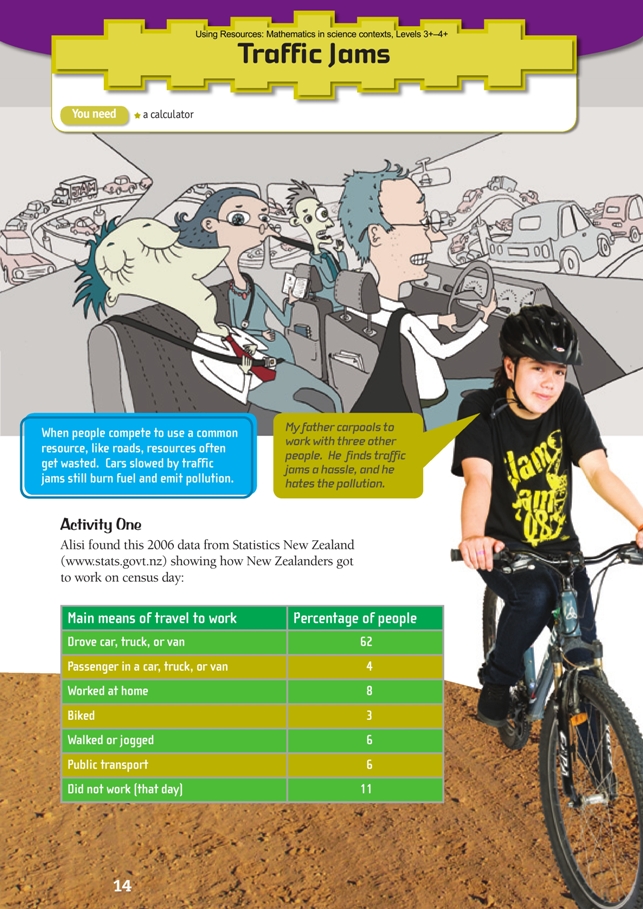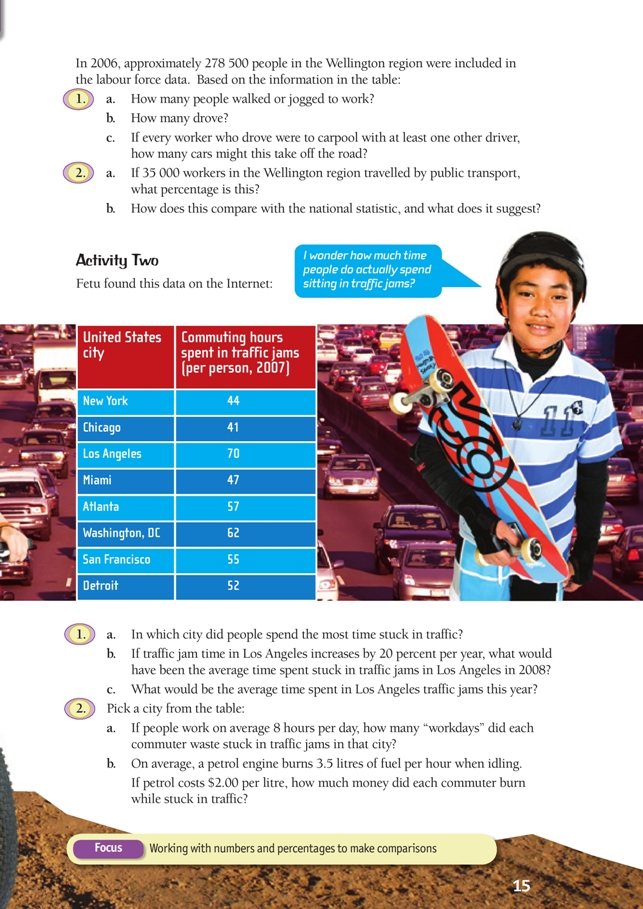This is a level (3+ to 4+) mathematics in science contexts activity from the Figure It Out series.
A PDF of the student activity is included.
Click on the image to enlarge it. Click again to close. Download PDF (1412 KB)
Students will:
- extract appropriate data from tables
- perform calculations with percentage and rate data
- convert between percentages and absolute quantities.
Students should discover that:
- significant amounts of time and money are wasted in traffic jams.
FIO, Using Resources, Levels 3+-4+, Traffic Jams, pages 14 - 15
Preparation and points to note
A useful introductory exercise is to discuss as a class the different ways that people travel to work and the pros and cons of these alternatives.
Decide in advance whether your students should work individually or in groups or pairs. Ask them to identify in the two tables the information they need to answer the different questions. No matter how they work, encourage them to discuss their results with other students. This will reinforce the key competency thinking by providing opportunities for students to learn from their mistakes, improve their processes, and refine their conclusions.
Points of entry: Mathematics
This activity approaches percentages and rates from three slightly different angles: (i) given a percentage, calculate the number/quantity; (ii) express one number as a percentage of another; and (iii) calculate a compounding increase (using repeated multiplication). Note that in Activity Two, question 1b-c, the students need to multiply by 120% per year. This is very different from Activity One, where they are calculating a single percentage or quantity.
Reinforce the key understanding that percentage is “parts out of 100” by, for example, asking the students to add up the figures in the table on page 14 of the students’ book. Also reinforce that percentages are fractions: 75% = 75/100 = 3/4 = 0.75, 120% = 120/100 = 6/5 = 1.2, and so on. The usefulness of the percentage form lies in its standardisation: because the denominator is always 100, it is very easy to compare the relative size of different percentages. Once students have this equality clear, they can be weaned off the practice of writing a percentage as a number over 100 and encouraged to use the decimal form that is so convenient in most percentage calculations. (Double strip diagrams are a useful tool for teaching the meaning of percentage [see NDP Book 7: Teaching Fractions, Decimals, and Percentages]. Another access point is using key percentages such as 10%, 1%, 50%.)
Note that Activity Two requires students to equate different types of unit (hours, workdays, litres, and dollars). Ask: Which of these units gives you the best idea of the cost of traffic jams? Why?
Points of entry: Science
This activity highlights what happens when people overuse a cheap resource (in this case, roads): overuse always generates costs, although these costs are not always obvious or taken into account. Encourage the students to reflect on the time, money, and fuel that is used to no purpose. Relate their comments from Activity One to the answers in Activity Two.
This activity makes a very suitable transition to the next activity, Common Pasture. Drivers share the available road just as calves share the available pasture.
Ask your students to think about why people often choose to drive their car instead of using the public transport options that may be available and to think creatively about solutions to traffic congestion. The focus for this could be a map of the area in which the students live. They may feel that there is no alternative to a car. If so, ask them to project themselves into a future where petroleum resources have been exhausted and no suitable substitute has been found. Ask How would we have to change the way we live?
Another approach would be to compare the different scenarios of a city that grows up around a well-designed public transport system and the city that tries to retrofit a good public transport system after having developed without one.
The questions in Activity One illustrate that change is possible; they ask students to compare Wellington’s public transport usage with the national average and to think about the impact of carpooling on the number of vehicles. You could extend this to a consideration of sustainability and how we could reduce our use of resources overall.
Answers
Activity One
1. a. 16 710 people. (6/100 x 278 500)
b. 172 670 people. (62/100 x 278 500)
c. Up to 86 335 cars. (172 670 people are driving. If each driver drove 1 other driver, there would be half as many cars.)
2. a. 12.6%. (35 000 ÷ 278 500 x 100)
b. The national percentage for workers who used public transport was 6%. In the Wellington region, the percentage was 12.6%, which is more than double. This suggests that Wellington may have more to offer in terms of public transport options than other major cities (for example, Wellington’s train system is bigger than Auckland’s, and Christchurch does not have trains). Those who live outside the major cities, particularly those who live in rural areas, often have no realistic alternative to driving when it comes to getting to work.
Activity Two
1. a. Los Angeles
b. 84 hours. (1.2 x 70. In other words, 70 hrs plus 20% more, which is 120% of 70)
c. If each year the time increases by 20%, that would be 84 hrs in 2008, 101 hrs in 2009 (1.2 x 84), 121 hrs in 2010 (1.2 x 101), and 145 hrs in 2011 (1.2 x 121). To find the amount of time for any year, just multiply the previous year’s figure by 120% or 1.2. (Note: the hours for each year have been rounded to the nearest whole number.)
2. a. Answers will vary depending on the city but will be the number of commuting hours ÷ 8. For example, for New York, 44 ÷ 8 = 5.5 workdays.
b. Answers will vary depending on the city but should be that city’s hours from the table doubled (for the $2) and multiplied by 3.5 (for the litres). For example, for New York, 44 x 2 x 3.5 = $308.

